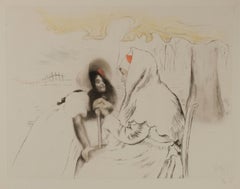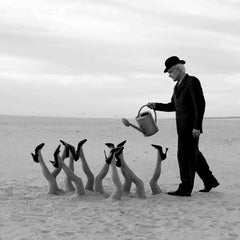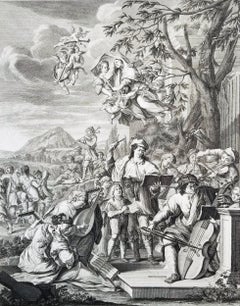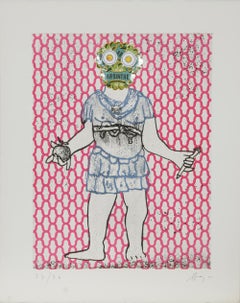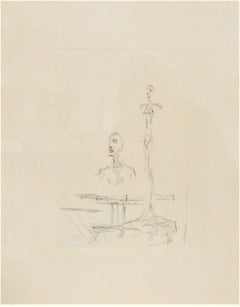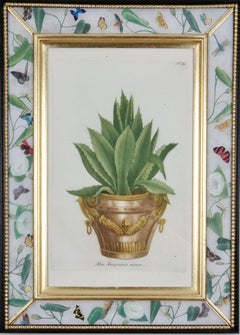Small Figurative Prints
to
1,430
23,247
7,603
7,245
3,333
1,849
Overall Width
to
Overall Height
to
2,263
1,603
505
456
362
208
151
149
100
75
63
15
5
4
113
100
89
70
63
753
1,006
4,393
1,451
80
65
211
139
215
294
787
1,010
385
304
594
4,490
2,767
339
4,828
2,515
1,771
1,619
1,356
1,278
821
743
442
408
304
283
221
211
206
206
204
181
179
178
2,736
2,449
1,345
502
414
947
3,135
3,592
3,225
Size: Small
L'Aieule (The Grandmother)
Located in Fairlawn, OH
L'Aieule (The Grandmother)
Etching and aquatint printed in colors, 1904
Signed with the red stamp of the publisher, Gustave Pellet, Lugt 1193 and numbered (see photo)
Edition: 100 (81/100)
Reference: Arwas 202 iv/IV
IFF 98
Condition: Excellent, the sheet aged as usual
Image size: 14 1/4 x 18 5/8"
Sheet size: 16 15/16 x 24 1/4"
Louis Auguste Mathieu Legrand (29 September 1863 – 1951) was a French artist, known especially for his aquatint engravings, which were sometimes erotic. He was awarded the Légion d'honneur for his work in 1906.
Life
Legrand was born in the city of Dijon in the east of France. He worked as a bank clerk before deciding to study art part-time at Dijon's Ecole des Beaux-Arts. He won the Devosge prize at the school in 1883.[2] In 1884 Legrand studied engraving under the Belgian printmaker Félicien Rops.
Legrand's artworks include etchings, graphic art and paintings. His paintings featured Parisian social life. Many were of prostitutes, dancers and bar scenes, which featured a sense of eroticism. According to the Hope Gallery, "Louis Legrand is simply one of France's finest early twentieth century masters of etching." His black and white etchings especially provide a sense of decadence; they have been compared to those of Henri de Toulouse-Lautrec, though his drawings of the Moulin Rouge, the can-can dance and the young women of Montmartre preceded Toulouse-Lautrec's paintings of similar scenes. He made over three hundred prints of the night life of Paris. They demonstrate "his remarkable powers of observation and are executed with great skill, delicacy, and an ironic sense of humor that pervades them all."
Two of his satirical artworks caused him to be tried for obscenity. The first, "Prostitution" was a symbolic drawing which depicted a naked girl being grasped by a dark monster which had the face of an old woman and claws on its hands; the second, "Naturalism", showed the French novelist Émile Zola minutely studying the thighs of a woman with a magnifying glass. Defended by his friend the lawyer Eugène Rodrigues-Henriques (1853–1928), he was found not guilty in the lower court, but was convicted in the appeal court and then given a short prison sentence for refusing to pay his fine.
Legrand was made famous by his colour illustrations for Gil Blas magazine's coverage of the can-can, with text by Rodrigues (who wrote under the pseudonym Erastene Ramiro). It was a tremendous success, with the exceptional quantity of 60,000 copies of the magazine being printed and instantly sold out in 1891.
In 1892, at the instigation of the publishing house Dentu, Legrand made a set of etchings of his Gil Blas illustrations. The etchings were published in a book, Le Cours de Danse Fin de Siecle (The End of the Century Dance Classes).
Legrand took a holiday in Brittany, which inspired him to engrave a set of fourteen lithographs of simple country life called Au Cap de la Chevre (On Goat Promontory). It was published by Gustave Pellet who became a close friend of Legrand's. Pellet eventually published a total of 300 etchings by Legrand, who was his first artist; he also published Toulouse-Lautrec and Félicien Rops among others.
He did not only work in graphics; he exhibited paintings at the Paris salon of the Société Nationale des Beaux-Arts starting in 1902. In 1906 he was made a chevalier of the Légion d'honneur.
Legrand died in obscurity in 1951. A retrospective exhibition was held at the Félicien Rops museum in Namur, Belgium in 2006 to celebrate his graphic art. The art collector Victor Arwas published a catalogue raisonné for the occasion.
Books illustrated
de Maupassant, Guy: Cinq Contes Parisiens, 1905.
Poe, Edgar Alan: Quinze Histoires d'Edgar Poe...
Category
Early 1900s Art Nouveau Figurative Prints
Materials
Aquatint
"In the Garden" Photography 24" x 24" inch Edition 3/15 by Olha Stepanian
Located in Culver City, CA
"In the Garden" Photography 24" x 24" inch Edition 3/15 by Olha Stepanian
Printed on Epson Professional Paper
Signed and numbered by the artist
Not framed. Ships in a tube.
...
Category
21st Century and Contemporary Contemporary Black and White Photography
Materials
Archival Paper
Vespera; Der Abend (Evening; The Evening) /// Johann Daniel Preissler Old Master
Located in Saint Augustine, FL
Artist: (after) Johann Daniel Preissler (German, 1666-1737)
Title: "Vespera; Der Abend (Evening; The Evening)"
Portfolio: Die Vier Tageszeiten (The Four Times of Day)
Year: 1723
Medium: Original Etching and Engraving on laid paper
Limited edition: Unknown
Printer: likely Johann Balthasar Probst, Augsburg, Germany
Publisher: Jeremias Wolff (Erben), Augsburg, Germany
Reference: Le Blanc No. 255, 38; Nagler No. 23
Sheet size: 22.5" x 16.63"
Image size: 17.38" x 13.63"
Condition: Soft handling creases and folds to sheet. Some scattered foxmarks in left margin. Two small tears skillfully repaired from verso in margins. Has been professionally stored away for decades. It is otherwise a strong impression in good condition with full margins
Extremely rare
Notes:
Provenance: private collection - Aspen, CO. Engraved by German artist Johann Balthasar Probst (1673-1750) after a drawing by German artist Johann Daniel Preissler (1666-1737). Comes from Preissler's 1723 "Die Vier Tageszeiten (The Four Times of Day)" portfolio of four etchings and engravings. Printed from one copper plate in one color: black. Descriptions of the portrayed image are printed in Latin and German.
Biography:
Johann Daniel Preissler, or Preisler (1666–1737) was a German painter and director of Nuremberg's Academy of Fine Arts. He was a notable member of a German artistic family, originating in Bohemia. His children included Johann Justin Preissler (1698–1771), Georg Martin Preisler (1700–1754), Barbara Helena Preisler (1707–1758; married to Oeding), Johan Martin Preisler (1715–1794), and Valentin Daniel Preisler (1717–1765), all in their time renowned artists. Most notable for his portraits, nudes and history paintings, Johann Daniel Preissler also produced drawings and frescoes. He was particularly known beyond his native Nuremberg for his "Die durch Theorie erfundene Practic", a sequence of works on art theory – the individual works were translated into several other languages and served as textbooks for students such as the Swiss Salomon Gessner...
Category
1720s Old Masters Figurative Prints
Materials
Laid Paper, Engraving, Etching
Flavius Valerius from The Romans, Modern Aquatint Etching by Enrico Baj
By Enrico Baj
Located in Long Island City, NY
Artist: Enrico Baj, Italian (1924 - 2003)
Title: Flavius Valerius Constantinus Chlorus
Year: 1972
Medium: Aquatint Etching with Collage, Signed and numbered in pencil
Edition: 24/70;...
Category
1970s Modern Portrait Prints
Materials
Mixed Media, Etching, Aquatint
The Search
Located in London, GB
Alberto Giacometti
The Search , ca. 1968
Restrike Etching
unsigned
comes with COA from publishers
25.4 × 20.3 cm
51 x 40.5 cm (framed)
Category
1960s Modern Figurative Prints
Materials
Lithograph
Johann Weinmann: 18th Century Engraving of an aloe in a decorative pot.
Located in Richmond, GB
Hand-coloured mezzotint engravings of decorative urns with aloes and cacti from: ""Phytanthoza Iconographia"", c1739, presented in hand- made, parcel-gilt, ebonised and decalcomania...
Category
18th Century Figurative Drawings and Watercolors
Materials
Watercolor, Mezzotint
Tête pensive
By Corneille
Located in Malmo, SE
Tête pensive.
Created 1998, engraving.
Publisher GKM.
Unframed.
Edition of 60 ex.
Signed, dated and numbered.
Free shipment worldwide.
Corneille, one of the founders of the COBRA ...
Category
1990s Contemporary Figurative Prints
Materials
Engraving
"Reverie" Black & White Photography 20" x 16" inch Edition 1/15 by Brendan North
Located in Culver City, CA
"Reverie" Black & White Photography 20" x 16" inch Edition 1/15 by Brendan North
Available sizes:
Edition of 15: 20" x 16" inch
Edition of 7: 30" x 24" inch
Edition of 3: 50" x 40"...
Category
21st Century and Contemporary Contemporary Black and White Photography
Materials
Archival Paper, Digital
Les Crimes de l'Amour - Etching by Hans Bellmer - 1968
By Hans Bellmer
Located in Roma, IT
Hand Signed. From the Portfolio "Petit Traité de Morale", Paris, Editions Georges Visat, 1968.
Copy on Velin d'Arches. Includes matting.
Hans Bellmer was a German artist, who, when...
Category
1960s Modern Figurative Prints
Materials
Paper, Etching
Guerrier (Guastalla, LR), Société internationale d'art XXe siècle
Located in Southampton, NY
Lithograph on vélin paper. Paper Size: 12.4 x 19.3 inches, with centerfold, as issued. Inscription: Unsigned and unnumbered, as issued. Catalogue raisonné references: Guastalla, Gior...
Category
1960s Modern Abstract Prints
Materials
Lithograph
$716 Sale Price
20% Off
Max Eisler Eine Nachlese folio "Portrait of Baroness Wittgenstein" collotype
Located in Chicago, IL
After Gustav Klimt, Max Eisler Plate #4, Bildnis Baronin Wittgenstein; dark grey monochrome collotype after the 1905 painting in oil on canvas.
GUSTAV KLIMT EINE NACHLESE (GUSTAV KLIMT AN AFTERMATH), a portfolio of 30 collotypes prints, 15 are multi-color and 15 are monochrome, on chine colle paper laid down on heavy cream-wove paper with deckled edges; Max Eisler, Editor-Publisher; Osterreichischer Staatsdruckerei (Austrian State Printing Office), Printer; in a limited edition of 500 numbered examples of which: 200 were printed in German, 150 were printed in French and 150 were printed in English; Vienna, 1931.
2018 marks the 100th anniversary of Gustav Klimt’s death. It is a fitting time to reflect upon the enduring legacy and deep impact of his art. Recognizing this need for posterity with uncanny foresight, the publication of Gustav Klimt: An Aftermath (Eine Nachlese) provides a rare collection of work after Klimt which has proven to be an indispensable tool for Klimt scholarship as well as a source for pure visual delight.
Approximately 25 percent of the original works featured in the Aftermath portfolio have since been lost. Of those 30, six were destroyed by fire on 8 May 1945. On that fateful final day of WWII, the retreating Feldherrnhalle, a tank division of the German Army, set fire to the Schloss Immendorf which was a 16th century castle in Lower Austria used between 1942-1945 to store objects of art. All three of Klimt’s Faculty Paintings: Philosophy, Medicine and Jurisprudence (1900-1907), originally created for the University of Vienna, were on premises at that time. Also among the inventory of Klimt paintings in storage there was art which had been confiscated by the Nazis. One of the most significant confiscated collections was the Lederer collection which featured many works by Gustav Klimt such as Girlfriends II and Garden Path with Chickens...
Category
1930s Vienna Secession Figurative Prints
Materials
Paper
Chagall, Sans titre (Cramer 61; Mourlot 434), Le plafond de l'Opéra (after)
By Marc Chagall
Located in Southampton, NY
Lithograph on vélin paper. Paper Size: 13 x 19 inches, with centerfold, as issued. Inscription: Signed in the plate and unnumbered, as issued. Catalogue raisonné references: Cain, Ju...
Category
1960s Expressionist Figurative Prints
Materials
Lithograph
$716 Sale Price
20% Off
Leaves of Love-Orange Lady plus Mermaid (two proof prints)
Located in Middletown, NY
A colorful, myth-based female nude along with a portriat of a mermaid by the same artist.
Lithograph in color on white wove paper, 18 1/4 x 11 3/4 inches (462 x 297 mm), full margin...
Category
Mid-20th Century Modern Nude Prints
Materials
Lithograph
Chariot of the Sun
Located in Paris, IDF
after Georges BRAQUE
Char of the Sun
MEDIUM : Lithograph
PRINTER : Atelier Art-Litho
EDITOR : Armand ISRAEL, Paris
SIGNATURE : Printed
LIMITED : 399 copies unumbered
PAPER : Arches ...
Category
Late 20th Century Cubist Figurative Prints
Materials
Lithograph
Le Déshabille, Impressionist Etching with Aquatint by Manuel Robbe, circa 1907
By Manuel Robbe
Located in Long Island City, NY
This etching with aquatint was created by French printmaker Manuel Robbe. Robbe’s innovative techniques, along with his sense of color harmony and his choice of subjects: stylish wom...
Category
Early 1900s Impressionist Figurative Prints
Materials
Etching, Aquatint
Converse Marilyn Sneakers Art by Martin Allen – Iconic Pop Culture Meets Vintage
Located in London, GB
Step into a world where iconic pop culture and timeless artistry converge with the “Converse Marilyn Sneakers Art” – a captivating masterpiece from the renowned artist Martin Allen. ...
Category
2010s Pop Art Figurative Prints
Materials
Pigment
Patitcha
Located in London, GB
Henri Matisse
Patitcha
1947
Aquatint on BFK Rives paper, Edition of 25
Paper size: 55.5 x 38 cms (22 x 15 ins)
Image size: 34.9 x 27.6 cm (13 3/4 x 10 7/8 ins)
HM15405
Selected Coll...
Category
1940s Modern Figurative Prints
Materials
Aquatint
$100,000
Peaceful Maternity : the Sleeping Baby - Etching
Located in Paris, IDF
Francois BOUCHER
Peaceful Maternity : the Sleeping Baby
Etching
Unsigned
On Vellum 38 x 50 cm (c. 15 x 20 in)
Probably edited c. 1950
Excellent condition
Category
20th Century Mannerist Figurative Prints
Materials
Etching
From: Ilsee, Princess of Tripoli Recto: "Dream Woman " Verso: "Visions "
Located in Milwaukee, WI
"From: Ilsee, Princess of Tripoli Recto: "Dream Woman" Verso: "Visions" is an original color lithograph by Alphonse Mucha. Exquisite double-sided color lithograph from "Ilsee, Princ...
Category
1890s Art Nouveau Figurative Prints
Materials
Lithograph
James Bond Dr. No. ‘Publicity Portrait’ 1962. Limited Ed ChromaLuxe Print & Book
By TASCHEN
Located in Los Angeles, CA
When the cinematic Bond was born.
The most complete account of the making of the first James Bond film, Dr. No (1962).
“Bond, James Bond.” Since Sean Connery uttered those immortal...
Category
21st Century and Contemporary Color Photography
Materials
Metal
Post Soviet Avant Garde Russian Woodcut Print With Hand Watercolor Painting
By Ilya Shenker
Located in Surfside, FL
This depicts a wedding scene in a style of German Expressionism. hand signed and hand painted in watercolor.
Ilya Shenker, Russian/American (1922 - )
As a soldier in World War II, he survived where millions perished. Upon returning to his home town of Odessa, felt abandoned and alone. He studied Art and Architecture in Odessa, but, one of a number of Russian Jewish artists allowed to emigrate, he left for America when the opportunity arose. He settled in New York City, a choice that has forever impacted his oeuvre. Many of his pictures depict New York cityscapes and lifestyle; however, they remain typically Russian. His subject matter often comes from memory and includes the life that he left behind, family, and friends. Drawing upon his Jewish heritage for inspiration, Shenker also paints historical events, such as "On the Eve of the Assault" in which he portrayed the last night before the destruction of Jerusalem. He has also illustrated a number of classics of Russian literature including Alexander Pushkin. His use of imagination also applies to the figures in his expressionist paintings—fictional characters such as the Spanish literary character Don Quixote make appearances in his work. He has also placed figures such as Rembrandt and Picasso in modern settings: in "Rembrandt Visiting our Family," Shenker sits his most favored artist at his family table, in a tribute to someone he describes as a "peoples artist." He is one in a long line of great Soviet Russian Judaica Jewish artists beginning with Yehuda Pen, who founded Russia's first art school for Jews in Vitebsk in 1897 continuing with his students, including Marc Chagall and El Lissitzky, Natan Altman, Leon Bakst and Robert Falk...
Category
1960s Expressionist Figurative Prints
Materials
Watercolor, Woodcut
Large Shelf Still Life, 2017, Offset lithograph
By Jonas Wood
Located in Hong Kong, HK
Large Shelf Still Life, 2017
Offset lithograph printed in colors on wove paper
23 2/5 × 23 2/5 in
59.5 × 59.5 cm
The full sheet printed to the ...
Category
2010s Pop Art Figurative Prints
Materials
Offset
Last Silver Dollar By Greg Singley, Original Signed Print
Located in Phoenix, AZ
Flip For It
Artist: Greg Singley
Signed original signature
Archival Pigment Print, 100% Rag Paper
Paper size: 24 x30 inches
Image Size: 20 x 26 inches
The art of Greg Singley have b...
Category
2010s Contemporary Figurative Prints
Materials
Archival Pigment
Luc Tuymans, Wenn der Frühling kommt - Portfolio including 17 Prints, Signed
By Luc Tuymans
Located in Hamburg, DE
Luc Tuymans (Belgian, b. 1958)
Wenn der Frühling kommt, 2007
Medium: Portfolio with 17 digital pigment prints on semi-transparent paper, mounted onto heavy rag paper
Dimensions: 50 x...
Category
21st Century and Contemporary Contemporary Figurative Prints
Materials
Digital Pigment
Late 19th century color lithograph art nouveau ornate bookplate figures floral
Located in Milwaukee, WI
From: Ilsée, Princesse de Tripoli "Ilsee and Jaufre" is an original color lithograph by Alphonse Mucha. Exquisite double-sided color lithographs from "Ilsee, Princesse de Tripoli," ...
Category
1890s Art Nouveau Figurative Prints
Materials
Lithograph
India Landscape Etching Original 1917 Limited Edition Signed Listed Artist Rare
Located in Norfolk, GB
Ernest Stephen Lumsden RE, RSA
(1883 – 1948)
Enthusiast
Image Size: 15cm x 30 cm
Sheet size: 21.5 cm x 35 cm
Mounted: 50cm x 41 cm
Lumsden reference: 254
Edition 33/50
Whatman ...
Category
1910s Figurative Prints
Materials
Paper, Etching
Series 347:301 (Raphael et Fornarina VI: Enfin seuls)
Located in New York, NY
A very good impression of this etching. Signed and numbered 35/50 in pencil by Picasso. Printed by Crommelynck, Mougins. Published by Galerie Louise Leiris, Paris. From "347 Gravures...
Category
1960s Modern Nude Prints
Materials
Etching
El Jardin de las Delicias, by Maximino Javier
Located in Palm Springs, CA
El Jardín de las Delicias by Maximino Javier was created in 1970. This date places it within a significant period of artistic exploration, reflecting the cultural and social themes p...
Category
1970s Surrealist Figurative Prints
Materials
Etching
$450 Sale Price
35% Off
H.O. Miethke Das Werk folio "Portrait of Marie Henneberg" collotype print
Located in Chicago, IL
DAS WERK GUSTAV KLIMTS, a portfolio of 50 prints, ten of which are multicolor collotypes on chine colle paper laid down on hand-made heavy cream wove paper with deckled edges; under ...
Category
Early 1900s Vienna Secession Figurative Prints
Materials
Paper
Tarkay Limited Edition Serigraph Titled " Sisters" Signed, Numbered & Framed
Located in Plainview, NY
A limited edition serigraph titled Sisters by Izchak Tarkay (Israel 1935 -2012) , a celebrated artist known for his vibrant, impressionistic style. The piece is rich in color and tex...
Category
21st Century and Contemporary Post-Impressionist Figurative Prints
Materials
Archival Paper
Jacob’s Vision, Guillaume Azoulay
Located in Fairfield, CT
Artist: Guillaume Azoulay (1949)
Title: Jacob’s Vision
Year: 2003
Edition: 44/50, plus proofs
Medium: Pigment print on wove paper
Size: 23 x 18 inches
Condition: Good
Inscription: Si...
Category
Early 2000s Pop Art Figurative Prints
Materials
Archival Pigment
$876 Sale Price
20% Off
R. Layni, Zeichnungen folio, "Portrait of a Child" Collotype plate X
Located in Chicago, IL
Egon Schiele (1890 – 1918), AUSTRIA
“ART CANNOT BE MODERN, ART IS PRIMORDIALLY ETERNAL.” -SCHIELE
Defiantly iconoclastic in life and art, Egon Schiele is esteemed for his masterful draftsmanship and precocious insight into the human condition. Part of the first wave of Austrian Modernism, he was swept away by the Viennese fascination with the tension between Life and Death (known in the works of Freud and his later interpreters as Eros and Thanatos). Life, identified with attraction, love, sexuality, and reproduction, and Death, represented by distortion, disease, repulsion, and hysteria, often appeared in the same composition, thereby suggesting the frightening life cycle of the human mind and body.
Young throughout his career, Schiele universalized his childhood traumas, thriving libido, insecurities, fears, and longings. His contorted line, jarring contrasts, and flat areas of color, demonstrate an early alliance with Expressionist philosophy and artists who were relentlessly frustrated by conventionality in all its forms. Schiele’s work embodied man’s disorientation and confusion in a seemingly absurd world, a world plagued by disease and war. It continues to be astonishingly relevant today, not just because it helped define Modernism but also because it revealed the dark and immutable aspects of the human condition.
Zeichnungen is a fine art print portfolio published by Verlag der Buchhandlung Richard Lanyi, Vienna, 1917, printed by Max Jaffe...
Category
1910s Vienna Secession Figurative Prints
Materials
Paper
“Untitled” from Pop Shop I
By Keith Haring
Located in Aventura, FL
Hand signed, numbered, and dated by the artist. Screenprint in colors, on wove paper, with full margins, Image size 10.5 x 13.375 inches.. Sheet size 12 x 15 inches. Frame size approx 17.25 x 20.25 inches Littmann p. 83. Published by Martin Lawrence...
Category
1980s Pop Art Figurative Prints
Materials
Paper, Screen
Going Bananas
Located in Greenwich, CT
Going Bananas is a lithograph on paper, 9.5 x 9 inches image size, and initialed 'BD' lower right. From the edition of 395, numbered 91/275 (there were also 100 Roman and 20 AP). Fra...
Category
21st Century and Contemporary Contemporary Prints and Multiples
Materials
Paper, Lithograph
Cleopatra
Located in New York, NY
A very good impression of this large color drypoint with strong colors. Signed and numbered 203/325 in pencil by Dali.
Catalogue reference: Michler/Löpsinger 820; Field 72-14.
Category
1970s Surrealist Abstract Prints
Materials
Color, Drypoint
Bokan - camouflage pink. Limited Edition (print) by Takashi Murakami, signed
Located in Hong Kong, HK
Bokan - camouflage pink, 2009 by Takashi Murakami
Offset print, numbered and signed by the artist
19 11/16 × 19 11/16 in
50 × 50 cm
Edition 71/300
About the Artist:
Takashi Murakami is best known for his contemporary combination of fine art and pop culture. He uses recognizable iconography like Doraemon and cartoonish flowers and infuses it with Japanese culture. The result is a colorful body of work that takes the shape of paintings, sculptures and animations.
In the 1990s, Murakami founded the Superflat movement in an attempt to expose the "shallow emptiness of Japanese consumeristic culture." The artist plays on the familiar aesthetic of mangas, Japanese-language comics, to render works that appear popular and accessible, all the while denouncing the universality and impersonality of consumer goods. Murakami has done collaborations with numerous brands and celebrities including Kanye West, Louis Vuitton...
Category
Early 2000s Pop Art Figurative Prints
Materials
Offset
Les Roses
Located in BOULOGNE-BILLANCOURT, FR
La composition de cette lithographie représente 3 roses vues en gros plan sur un fond de paysage bucolique, mêlant un parterre de fleurs blanches et, au second plan, quelques silhoue...
Category
Early 1900s Art Nouveau Figurative Prints
Materials
Lithograph, Paper
Compositions I et II (Cramer 207; Mourlot 1078-1079), Les Révolutions Scéniques
By Joan Miró
Located in Southampton, NY
Lithographs on vélin paper. Paper Size: 13.5 x 10 inches, each. Inscription: Unsigned and unnumbered, as issued. Catalogue raisonné references: Cramer, Patrick, and Joan Miró. Joan M...
Category
1970s Surrealist Abstract Prints
Materials
Lithograph
$1,116 Sale Price
20% Off
The Sea Itself from the Rilke Portfolio, Minimalist Lithograph by Ben Shahn
By Ben Shahn
Located in Long Island City, NY
Artist: Ben Shahn, American (1898 - 1969)
Title: The Sea Itself from the Rilke Portfolio
Year: 1968
Medium: Lithograph on Arches, signed in the plate
Edition: 750
Size: 22.5 x 17.75 ...
Category
1960s Modern Figurative Prints
Materials
Lithograph
Le Loup et le Chien - Lithograph by Hermann Paul - Early 20th Century
Located in Roma, IT
Le loup et le Chien is a Lithograph realized by Paul Hermann in 1905 ca.
Good conditions except for some foxings.
Hand-singed.
Numbered. edition, 1/5
The art work is depicted in ...
Category
Early 20th Century Modern Figurative Prints
Materials
Paper, Lithograph
Two Acrobats from Derriere le Miroir, Modern Lithograph by Alexander Calder
Located in Long Island City, NY
Artist: Alexander Calder, American (1898 - 1976)
Title: Two Acrobats from Derriere le Miroir
Year: 1975
Medium: Lithograph
Size: 15 in. x 11 in. (38.1 cm x 27.94 cm)
Frame Size: 23 x...
Category
1970s Modern Figurative Prints
Materials
Lithograph
Ballet und Pantomime "Der Paradiesvogel" (Bird of Paradise) plate #1.
Located in Chicago, IL
Walter Schnackenberg’s style changed several times during his long and successful career. Having studied in Munich, the artist traveled often to Paris where he fell under the spell o...
Category
1920s Art Deco Figurative Prints
Materials
Paper
H.O. Miethke Das Werk folio "Black Feather Hat" collotype print
Located in Chicago, IL
DAS WERK GUSTAV KLIMTS, a portfolio of 50 prints, ten of which are multicolor collotypes on chine colle paper laid down on hand-made heavy cream wove paper with deckled edges; under ...
Category
Early 1900s Vienna Secession Figurative Prints
Materials
Paper
H.O. Miethke Das Werk folio "Portrait of Helene Klimt" collotype print
Located in Chicago, IL
DAS WERK GUSTAV KLIMTS, a portfolio of 50 prints, ten of which are multicolor collotypes on chine colle paper laid down on hand-made heavy cream wove paper with deckled edges; under ...
Category
Early 1900s Vienna Secession Figurative Prints
Materials
Paper
H.O. Miethke Das Werk folio "The Family" collotype print
Located in Chicago, IL
DAS WERK GUSTAV KLIMTS, a portfolio of 50 prints, ten of which are multicolor collotypes on chine colle paper laid down on hand-made heavy cream wove paper w...
Category
Early 1900s Vienna Secession Figurative Prints
Materials
Paper
H.O. Miethke Das Werk folio "Portrait of Lady in Red and Black" collotype print
Located in Chicago, IL
DAS WERK GUSTAV KLIMTS, a portfolio of 50 prints, ten of which are multicolor collotypes on chine colle paper laid down on hand-made heavy cream wove paper with deckled edges; under each of the 50 prints is a gold signet intaglio...
Category
Early 1900s Vienna Secession Figurative Prints
Materials
Paper
Max Eisler Eine Nachlese folio "Lady in a Feathered Hat" collotype
Located in Chicago, IL
After Gustav Klimt, Max Eisler Plate #2, Dame mit Blumenhut (aka The Violet Hat); sepia monochrome collotype after the 1909 painting in oil on canvas.
...
Category
1930s Vienna Secession Figurative Prints
Materials
Paper
Deseaes of the Stomach of Epiploon - Lithograph By Ottavio Muzzi - 1843
Located in Roma, IT
Deseaes of the Stomach of Epiploon is a lithograph hand colored by Ottavio Muzzi for the edition of Antoine Chazal,Human Anatomy, Printers Batelli and Ridolfi, realized in 1843.
Si...
Category
1840s Modern Figurative Prints
Materials
Lithograph
Diseases of the Intestines- Lithograph By Ottavio Muzzi - 1843
Located in Roma, IT
Diseases of the Intestines is a lithograph hand colored by Ottavio Muzzi for the edition of Antoine Chazal,Human Anatomy, Printers Batelli and Ridolfi, realized in 1843.
Signed on p...
Category
1840s Modern Figurative Prints
Materials
Lithograph
Diseases of the Larynx, Trachea and Thyroid - Lithograph By Ottavio Muzzi - 1843
Located in Roma, IT
Diseases of the Larynx, Trachea and Thyroid Body is a lithograph hand colored by Ottavio Muzzi for the edition of Antoine Chazal,Human Anatomy, Printers Batelli and Ridolfi, realized...
Category
1840s Modern Figurative Prints
Materials
Lithograph
Project for documenta IV, Gelatin Silver Print, Signed to Roy Lichtenstein's ex
Located in New York, NY
Christo and Jeanne-Claude
Project for documenta IV, Kassel, 5600 Cubicmeter Package, 1968
Gelatin silver print.
Boldly signed, dated, numbered 12/50 and inscribed in black marker by...
Category
1960s Pop Art Figurative Photography
Materials
Silver Gelatin
Dufy, Composition, Les Côtes Normandes (after)
By Raoul Dufy
Located in Southampton, NY
Lithograph on grand vélin d'Arches spécial paper. Unsigned and unnumbered, as issued. Good condition with centerfold, as issued. Notes: From the folio, Les Côtes Normandes 1961. Publ...
Category
1960s Modern Landscape Prints
Materials
Lithograph
$1,516 Sale Price
20% Off
Peynet "Le Marché Aux Oiseaux"
Located in Saint Ouen, FR
Peynet (1908-199
Lithograph + original drawings
Le Marché aux Oiseaux” (The Bird Market)
1985
Number 30/350
Signed in pencil
76 x 56 cms
Category
1980s Figurative Prints
Materials
Paper
David Brings the Gold Shield to Jerusalem, Renaissance Engraving by Raphael
Located in Long Island City, NY
Raphael Sanzio da Urbino, Italian (1483 - 1520) - David Brings the Gold Shield to Jerusalem, Year: 1649, Medium: Engraving on laid paper, plate signed, Size: 9.5 x 11 in. (24.13 x...
Category
1940s Old Masters Figurative Prints
Materials
Engraving
Untitled (Frankenstein)
Located in Berkeley, CA
Hardground Etching
Category
2010s Figurative Prints
Materials
Etching
Johann Weinmann: c.18th Engravings of Fruit in Decalcomania Frames
Located in Richmond, GB
Hand-coloured mezzotint engravings from: ""Phytanthoza Iconographia"", c1739, presented in hand-made parcel-gilt, ebonised and decalcomania frames.
Johann Weinmann (1683-1741), a G...
Category
18th Century Figurative Drawings and Watercolors
Materials
Watercolor, Mezzotint
Dédié a Madame Vve. Charlet - Original Lithographs by Hippolyte Bellangé - 1846
Located in Roma, IT
Dédié a Madame Vve. Charlet is an original artwork realized by Hippolyte Bellangé in 1846.
Original lithograph on paper. The title appear on the lo...
Category
1840s Modern Figurative Prints
Materials
Lithograph
H.O. Miethke Das Werk folio "Portrait of Gertha Felsövanyi" collotype print
Located in Chicago, IL
DAS WERK GUSTAV KLIMTS, a portfolio of 50 prints, ten of which are multicolor collotypes on chine colle paper laid down on hand-made heavy cream wove paper with deckled edges; under ...
Category
Early 1900s Vienna Secession Figurative Prints
Materials
Paper
H.O. Miethke Das Werk folio "Portrait of Paula Zuckerkandl" collotype print
Located in Chicago, IL
DAS WERK GUSTAV KLIMTS, a portfolio of 50 prints, ten of which are multicolor collotypes on chine colle paper laid down on hand-made heavy cream wove paper with deckled edges; under ...
Category
Early 1900s Vienna Secession Figurative Prints
Materials
Paper
H.O. Miethke Das Werk folio "Portrait of Hermine Gallia" collotype print
Located in Chicago, IL
DAS WERK GUSTAV KLIMTS, a portfolio of 50 prints, ten of which are multicolor collotypes on chine colle paper laid down on hand-made heavy cream wove paper with deckled edges; under ...
Category
1910s Vienna Secession Figurative Prints
Materials
Paper
Recently Viewed
View AllMore Ways To Browse
Kim Tschang Yeul
Salvador Dali Paradise Lost
Salvador Dali Pegasus
Salvador Dali The Alchemist
Salvador Dali The Horseman
Salvador Dali The Kiss
Salvador Dali The Ship Of Souls
Salvador Dali Woman With A Whip
Sasaki Plates
Sebastien Leclerc
Shag Agle
Shag Josh Agle
Sol Y Dali
Tadashige Ono
Takashi Murakami Panda With Cubs
Tom Blackwell On Sale
Tom Everhart Lithograph
Torii Kotondo
